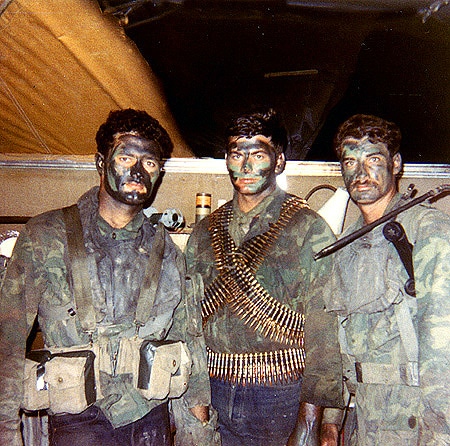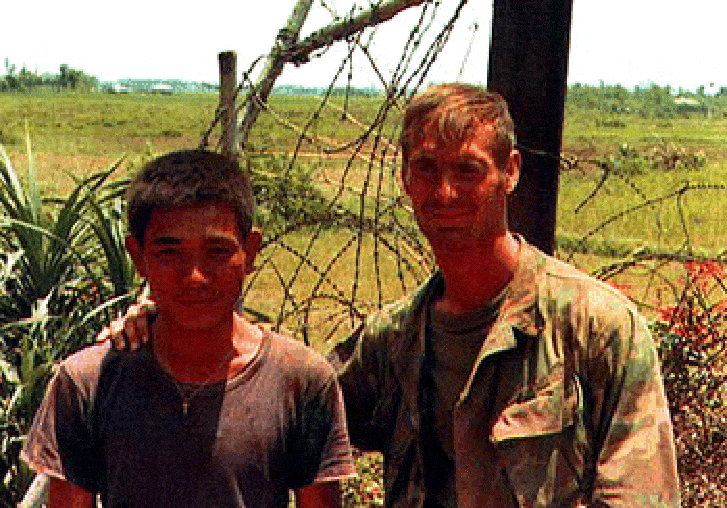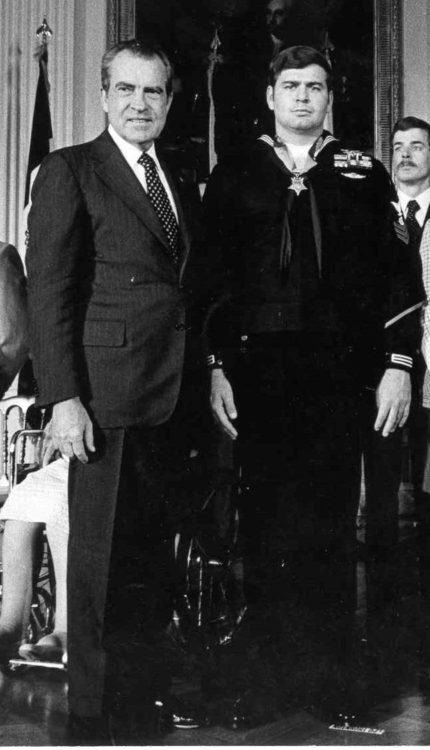HOW A NAVY SEAL EARNED A MEDAL OF HONOR … SAVING ANOTHER SEAL WITH A MEDAL OF HONOR
- By Stavros Atlamazoglou
Share This Article

Receiving the Medal of Honor is an exceptional and rare honor that very few Americans have earned. Most Medals of Honor are posthumous, reflecting the near-impossible odds one has to surmount to earn the nation’s highest award for bravery under fire.
Usually, living recipients of the Medal are so incapacitated from their wounds that they retire. Those who are still able-bodied, are pulled off operational duties and are given more administrative and public affairs tasks.
Medals of Honor are rare. But what is even rarer is to have one Medal of Honor recipient save the life of another. There have only been three instances of this happening in history, and one of them took place during a clandestine operation deep behind enemy lines in Vietnam.
Extraordinary Valor Under Fire
October 31, 1972.
Petty Officer Mike Thornton and Lieutenant Tom Norris were some of the last Navy SEALs in Vietnam. By then, the unpopularity of the war back home and Vietnamization of the conflict (a policy introduced by the Nixon administration to withdraw U.S. troops while equipping South Vietnamese forces) had left only a shadow of U.S. military presence in the Southeast Asian country.
The two SEALs were with the secretive Military Assistance Command Vietnam-Studies and Observations Group (MACV-SOG), a special operations organization that conducted covert cross-border operations in Cambodia, Laos, Thailand, and North Vietnam—where U.S. troops weren’t supposed to be.

Related: MACV-SOG, THE COVERT SPECIAL OPERATIONS UNIT YOU’VE NEVER HEARD OFF
Thornton, by now a veteran of several combat tours in Vietnam, and Norris were chosen for a strategic reconnaissance and prisoner catching operation. The two American commandos were joined by three Vietnamese LDNN (SEALs), two enlisted, and one officer. Throughout the war, U.S. Navy SEALs had worked closely with the LDNNs, training, advising, and leading them for years, so the two communities shared a close bond of comradeship.
The five-man team began a 50-mile transit down a river on small Vietnamese junks that had a maximum speed of craft 8 knots. It took them approximately six hours to get out to the sea. Once there, they remained well off the shore as they traveled, so no one could guess in which direction they would be heading. Then they boarded some small rubber boats and paddled north very close to the Demilitarized Zone (DMZ). Approximately a mile off land, they went into the water and swam to the beach. However, without them realizing it, they had actually passed the DMZ, and were now in Quang Tri in North Vietnam.
Related: COWBOY, A LEGENDARY VIETNAMESE COMMANDO
Once on shore, they quickly realized that they were in deep enemy territory with multiple units nearby. As they remained hidden, they located a two-man North Vietnamese patrol, which they attempted to snatch, however, one NVA broke off contact, and Thornton had to chase him into the jungle. Suddenly, hundreds of enemy fighters emerged from the foliage and started pouring heavy fire into the area the American commandos were hidden. Surrounded, the SEALs fought like men possessed, calling in gunfire from the boats they arrived in and even from Navy ships offshore. At one point, Norris was shot in the head, and the South Vietnamese SEALs left him for dead. But not Thornton. The SEAL petty officer went back into the fight and carried the severely wounded Norris.

Thornton’s Medal of Honor citation speaks for itself:
“The patrol called in naval gunfire support and then engaged the enemy in a fierce firefight, accounting for many enemy casualties before moving back to the waterline to prevent encirclement. Upon learning that the senior adviser [Lt. Tommy Norris] had been hit by enemy fire and was believed to be dead, PO [Petty Officer] Thornton returned through a hail of fire to the lieutenant’s last position, quickly disposed of two enemy soldiers about to overrun the position, and succeeded in removing the seriously wounded and unconscious Senior Naval Advisor to the water’s edge. He then inflated the lieutenant’s lifejacket and towed him seaward for approximately two hours until picked up by support craft.
By his extraordinary courage and perseverance, PO Thornton was directly responsible for saving the life of his superior officer and enabling the safe extraction of all patrol members, thereby upholding the highest traditions of the U.S. Naval Service.â€

Then a naval artillery shell struck nearby, throwing both men in the air and further wounding them. Thornton entered the water with a barely conscious Norris on top of him and began swimming. At that moment, a Vietnamese SEAL was also wounded, so Thornton went back for him too, swimming with both men under a hail of gunfire from the beach.
Eventually, the team was picked up by a Navy ship and the men were evacuated to safety and urgent medical attention. Norris ended up surviving his terrible head wound. He would go on to receive the Medal of Honor a year after Thornton for his actions during a previous special operation.
Related: THE AIR COMMANDO WHO DIED SO OTHERS MIGHT LIVE
The two enlisted Vietnamese SEALs who were part of the team later became U.S. citizens in recognition of their services during the war.

Thornton went on to have a lengthy career in the Naval Special Warfare community. He completed an exchange tour with the British Special Boat Service (SBS) before joining the newly established SEAL Team 6 as a plank holder, or founding member, in 1980. Later, he was commissioned as an officer and ultimately retired from service as a lieutenant (O-3) in 1992.
The Medal of Honor
Established in 1862 by a joint resolution of Congress, the Medal of Honor is the highest award for valor in action against an enemy power that a service member can earn.
Only actions of extraordinary personal bravery or self-sacrifice that involve risk of life qualify for consideration for the Medal, and the action has to be so conspicuous that it clearly singles out the individual from his peers. The Medal of Honor was first issued during the Civil War, which is also the conflict with the most Medal of Honors awarded (1523).
There have been 3,527 medals awarded to 3,508 recipients. There have been 19 individuals who have received the Medal of Honor twice. Only one female has ever earned the medal. In addition, the Medal of Honor is the only award and decoration in the U.S. military that is worn around the neck and not pinned on the uniform.
Related Posts
Sandboxx News Merch
-

‘AirPower’ Classic Hoodie
$46.00 – $48.00 Select options This product has multiple variants. The options may be chosen on the product page -

‘Sandboxx News’ Trucker Cap
$27.00 Select options This product has multiple variants. The options may be chosen on the product page -

‘Kinetic Diplomacy’ Bumper Sticker (Black)
$8.00 Add to cart
Stavros Atlamazoglou
Greek Army veteran (National service with 575th Marines Battalion and Army HQ). Johns Hopkins University. You will usually find him on the top of a mountain admiring the view and wondering how he got there.
Related to: Military History, Special Operations

Could France undertake the role of Europe’s nuclear protector? Potentially

What are the differences between the six generations of fighter aircraft?
Sandboxx News
-

‘Sandboxx News’ Trucker Cap
$27.00 Select options This product has multiple variants. The options may be chosen on the product page -

‘AirPower’ Classic Hoodie
$46.00 – $48.00 Select options This product has multiple variants. The options may be chosen on the product page -

‘AirPower’ Golf Rope Hat
$31.00 Select options This product has multiple variants. The options may be chosen on the product page -

‘Sandboxx News’ Dad Hat
$27.00 Select options This product has multiple variants. The options may be chosen on the product page
